
10 minute read
Are you faced with disease problems on your plants?
When starting out with greenhouse farming, often the operators in the greenhouses are not fully equipped to notice diseases and sometimes even forget the image of the particular disease on plants. This is a re-introduction to the major diseases that one may face on your greenhouse plants.
Advertisement
Any plant that deviates from its normal growing pattern can be seen as diseased. There are many factors that can contribute to the growth of plants and these factors have to be taken into account when diagnosing a potential disease problem. Depending on the living status of the causal factors, diseases can be infectious or non-infectious. Live organisms or pathogens will be the cause of infectious diseases whereas unfavourable growing conditions cause non-infectious diseases. It is very important to know the actual main cause of the disease to be able to decide on control measures. Non-infectious diseases can therefore be a result of normal stress growing conditions which includes insufficient light, extreme temperatures (too hot or cold), poor aeration or water drainage of growth
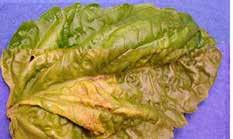
Downy Mildew on ‘Mammoth’ basil.
medium, too much or too little water, toxic levels of certain nutrients, nutrient deficiencies, unfavourable pH (acidity or alkalinity) of the soil, high soluble salts, soil compaction, injury from pesticides and fertilizers, physical or mechanical damage and many more conditions. Of importance is that noninfectious problems do not spread from one diseased plant to another as can be the case with infectious diseases caused by living entities, but they actually arise suddenly in a specific spot and the problems show simultaneously on a number of plants in the same area. Poor plant health is mainly a result of poor growing conditions. Parasitic organisms on the other hand are the main cause of infectious diseases. These organisms include fungi, bacteria, viruses, nematodes, mycoplasmas and viroids. The infected plant in this case is referred to as the host plant, and many infectious diseases are very host specific. Basic knowledge of the plants’ ideal growing conditions, water and nutrient needs as well as the susceptibility of the plant to certain infectious diseases can enable one to have a perfect healthy crop. In order to understand where plant diseases come from one needs to have a closer look at the various pathogenic parasites causing infectious diseases, and combined with the necessary knowledge of growing conditions, we should be able to prevent the development of such diseases in the greenhouse. When it comes to disease control, prevention is always better than cure. It is quite often impossible to cure a plant if the disease is already in an advance stage. In such a case complete removal of a very sick plant is normally the best approach.

Tomato Septoria leaf spot.
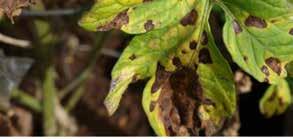
Tomato powdery mildew.

Before starting to remove plants, have a look at the possible causes of such diseased or poor performance plants. There are more than 80 000 diseases recorded worldwide, but only a small number of these diseases affect a plant or variety. Disease causing pathogens often establish themselves in areas of mass production of cultivated plants. The most common disease causing pathogens are fungi, bacteria, viruses, nematodes, mycoplasmas, and viroids.
Fungi
In the plant kingdom fungi are very simple, sometimes microscopic small plants
14
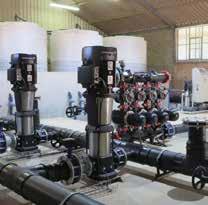
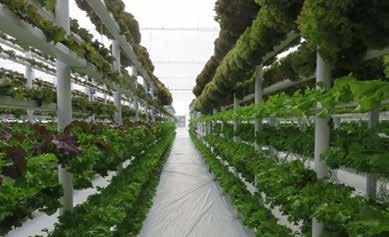
Cherry Irrigation is an innovative company with more than 30 years’ experience in the specialist field of agricultural irrigation Cherry Irrigation systems design and supply. With its head office in South Africa’s Western Cape, the - specialists in irrigation company also has independent registered affiliates in Namibia and Angola, and has solutions successfully completed irrigation projects in South Africa, Angola, Namibia, Botswana, Zimbabwe and Tanzania. Hydroponics Lettuce Project Greendrop Farms
The inhouse team designs and installs all types of Multispan- • Irrigation system designs irrigation systems for all types of crops, including TunnelProject Hoopenberg • Drip, overhead systems and pivot irrigation fertigation and automation systems. Muldersvlei • Supply, installation and maintenance The company keeps up to date with of irrigation and crop management the latest trends and innovations in High-quality products agricultural methods and technologies, products • Pumps, filters and mainlines and provides training in the use of the from reputable • Automation and fertigation systems products that are supplied. manufacturers are a given. • Soil analysis and soil maps Cherry Irrigation’s design package The team builds long-term relationships • Electrical conductivity, pH, soil moisture includes the full range of consultation, soil with clients by really listening to their and climate sensors and control assessment, topographical surveys and needs and working to find the best water • Water measurement and in-field water irrigation planning, although these activities and energy-efficient solutions within the meter verification services can also be offered as distinct services scope of the requirements. • Solar solutions according to clients’ requirements. Specialised services offered are: • Training Contact Cherry Irrigation at +27 21 859 4246 l info@cherryirrigation.com l www.cherryirrigation.com

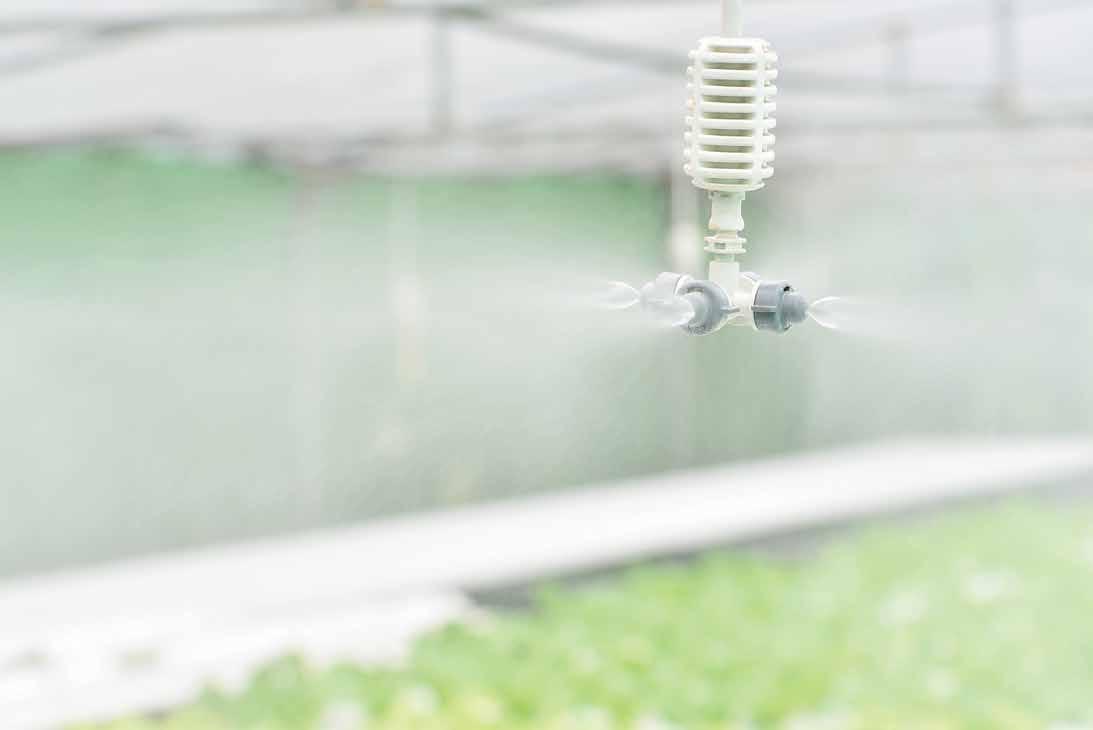
greeNhOUSeS I Shade Net I hYdrOpONIcS I aqUapONIcS are YOU Faced wIth dISeaSe prOblemS? 12 to prevent the spreading to other areas plants. The majority of diseases can be which can either grow on a living plant or dead organic matter like dead leaves or manure to obtain food. In general fungi lack chlorophyll and those that live on live host plants are called parasites and the one’s that live on dead organic matter saprophytes. Some fungi survive by attacking live plants at certain times and at other times they can be saprophytic in the soil or on plant debris. A fungus normally starts its life as a microscopic spore which can be looked at as the same development of plants from seed. After germination tubular threads develop known as hyphae which grow and develop further into a mycelium. Such parasitic mycelium might have the appearance of cobweb-like, whitish threads as is the case with powdery mildew or dark coloured filaments known as sooty mold. It is also possible that the mycelium can be completely within the host plant and not visible at all, as is the case with fungi causing wilting and rotting. of the plant. As bacteria migrate through plants they can also cause chlorosis (yellowing) as well as water soaked spots as a result of toxins released. The spreading of infectious bacteria can occur through mechanical means when grafting or pruning, cultivation, infested seed or tubers and other vegetative parts of an infested plant. Various animals, insects, nematodes and mites, as well as splashing water and dust carried by wind can act as agents in the spreading of bacteria. Warm and wet weather favour the development of bacterial diseases and the most common one’s known to us are soft rots, stem cankers , leaf and stem blights, wilts, galls, blotches and most easily recognized leaf spots. Bacteria can be dormant for months under unfavourable conditions and can live under either on or in plants, seed, vegetative parts of plants, implements and everyday garden tools, soil, plant containers, and even certain living insects. It is known that many pathogenic bacteria are killed by very high spread in nature by especially leafhoppers and aphids, a few by mealybugs, whitefly, thrips, grasshoppers, scales and even certain beetles. As a rule almost all viruses can be spread by vegetative propagation, which includes growing plants from cuttings, parts of seed, division of tubers and rhizomes, bulbs, and even parasitic plants like dodder. A small group of round 50 viruses can be transmitted by seed, pollen, fungi, nematodes, microscopic animal life as well as slugs and snails. Once a plant is infected with virus it remains like that for the rest of its life. Viroids A fairly new class of infectious particles called viroids has been identified that cause diseases that were previously mistaken for viral diseases. These viroids are 80 times smaller van the smallest virus. They act just like viruses by invading plant cells and as a result disrupting their functions. Viroids are known to cause “chrysanthemum stunt”. Mycoplasmas Mycoplasmas are one-celled, free-living Fungi spread by means of their spores temperatures, dry conditions and sunlight. organisms that cause typical “yellows” carried by air currents, water, birds, There are also animal life in the soil and “witches-broom” diseases. They insects, spiders, slugs, seeds, vegetative that prey on many pathogenic bacteria, are smaller than bacteria and reproduce parts of plants during propagation, therefore the importance of protecting by means of budding, very much the pruning equipment and last but not least and enhancement of various micro- same way as yeasts will do. Leafhoppers man. Some fungi called sclerotia do not organisms in soils. are known to be the transmitter of produce spores and multiply by forming Viruses mycoplasmas. compact hyphae or the actual fungal body divides into fragments which are broken off and spread by water, wind and other means. Damp conditions favour fungi development more than dry conditions. Most fungi that infect flowers, leaves, Acting like living organisms when in living cells, viruses are complex macromolecules that infect and replicate, and in most cases mutate. They are much smaller than bacteria and can only be seen with an electron microscope. The only way to Nematodes There are thousands of nematode species. Most is harmless, feeding primarily on decomposing organic matter as well as other soil organisms. Several hundreds are seen as beneficial in controlling soil pests. stems or fruit require a wet surface detect viruses on plants is by the visual Plant-parasitic nematodes have needle-like during spore germination and penetration symptoms showing on leaves or their stylet mouthparts which suck juices from and moisture is also essential for rapid effect on growth. living plants. reproduction and spreading. Certain fungi can not survive in soil for a long period without a host plant, where others live for a long time without a host. Symptoms of different viruses may differ depending on the plant variety or crop. The virus causes different genetic information to be sent out to the Diseases develop as a result of nematode feeding damage which allows easy entrance for wilt and root rot producing fungi, bacteria and other nematodes. A Bacteria biosynthetic apparatus of the plant cell, nematode infested plant is normally more Most bacteria species known is harmless which results in host cells to reproduce susceptible to drought, winter injury, and are seen as more beneficial to us. more altered viral particles. disease and insect attack. Some are known to cause animal and human diseases, where others can induce diseases in plants. Bacteria need to enter plant tissue through wounds caused by mechanical damage, insects or weather or The most common diseases caused by viruses are spotted wilts, mosaic, ring spots, mottles, stunts, yellows and streaks. Many times nutrient deficiencies are mistaken for virus-induced diseases. Common symptoms of nematode injury include stunting, yellowing, loss of green colour, twig and shoot die-back, temporary wilting and lack of response to general watering and feeding. Mostly natural openings like stomata and scars. Environmental conditions play a huge nematodes cause poor root health They can be present in soil, water, air, role in crops and weeds harbouring virus where in other cases root-feeding animals, plants and humans and they have and quite often no symptoms show at nematodes show no specific symptoms. the ability to multiply very quickly. temperatures above 30ºC. Quite often Infested plants are weakened and can Systemic infections of bacteria in plant virus symptoms are confused with nutrient easily be mistaken for symptoms caused tissue can cause typical necrotic spots, deficiencies and imbalances, insect- by drought, sunburn, frost, nutrient leaf spots, wilting, or soft rots of tissue induced toxemias, pesticide injury, genetic deficiencies, mite and or insect damage to due to the destruction of plant cells by mutations and mite feeding damage. roots, leaves, roots or stems, or common the bacteria. Once bacteria have entered A couple of virus diseases can spread via diseases like wilts, crown and root rots. plant tissue there is not much one can do workers hands from diseased to healthy By: Johan Gerber







